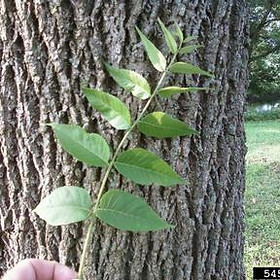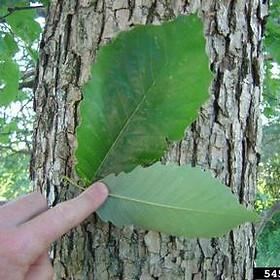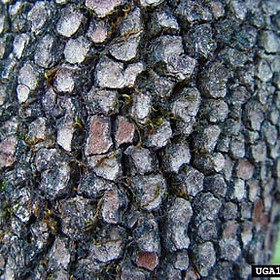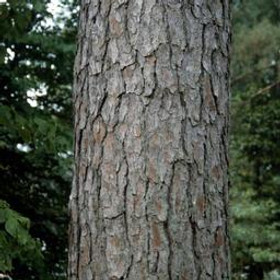Trees
More Information For Identifying Trees
When identifying trees, it’s important to observe the whole tree, not just the leaves. Ask yourself these questions to help identify the tree:
-
Is the tree deciduous or evergreen?
-
If deciduous, how are the leaves arranged on the branches (opposite, alternate, or whorled)?
-
If evergreen, are the leaves needle-like, scale-like, or something else?
-
What is the color and texture of the bark? Is it blocky, flaky, warty, or smooth? Are there any distinguishing marks like "x" shapes?
-
Are there any visible thorns, fruits, nuts, cones, or flowers? What is their color and shape?
Once you’ve answered a few of these questions (and if you're observing a deciduous tree with leaves), focus more closely on the leaves themselves. Here are key questions to consider when examining leaves:
-
What is the shape of most of the leaves?
-
What do the leaf margins look like (smooth, serrated, lobed, etc.)?
-
How do the leaf veins appear (parallel, pinnate, palmate)?
-
Do you notice any fuzz on the twigs or leaves? Where is it located?
-
What is the color of the leaves? Are the top and underside the same color?
-
Are the leaves simple or compound? If compound, how many leaflets do you see?
Deciduous vs. Evergreen Trees
Almost all deciduous trees have broad, flat leaves that fall to the ground in autumn and regrow each spring. (There are a small minority of needle-leaved trees which lose all their needles in the fall, such as the bald cypress.) Larger flat leaves provide more surface area than needles, which helps maximize sunlight for photosynthesis during the growing season. However, during the winter, when light is reduced in the Northern Hemisphere, these trees conserve energy by dropping their leaves, halting photosynthesis. Examples of deciduous trees include oaks, maples, hickories, dogwoods, elms, and ashes.
Image: c Kimberly Mitchell Only in Arkansas https://onlyinark.com/homegrown/arkansas-trees/
Evergreen trees, on the other hand, retain their leaves year-round. Their needle- or scale-like leaves are adapted to cold weather, with a waxy coating to prevent water loss and freezing. These leaves are also compact, preventing snow buildup, allowing evergreens to photosynthesize even in winter. Examples of evergreen trees include pines, cedars, spruces, firs, and hemlocks. In the Ozarks, we have only three native evergreen species: the shortleaf pine (Pinus echinata), Eastern red cedar (Juniperus virginiana), and the American Holly (Ilex opaca).
Image: c Robert O’Brien Trees of Texas http://texastreeid.tamu.edu/content/TreeDetails/?id=70


Leaf Arrangements
In the Ozarks, deciduous trees exhibit three main leaf arrangements, which help in tree identification. This characteristic can be checked first to eliminate large groups of trees and narrow your search.
Opposite: Two leaves or branches originate from the same point on the stem. In the Ozarks, this arrangement is common in maples, ashes, dogwoods, and buckeyes.
-
Use the acronym MAD Cap Horse to remember:
-
Maples, Ashes, Dogwoods, Caprifoliaceae (honeysuckles, viburnums, elderberries), and Horse chestnuts (including buckeyes).
Alternate: Leaves or branches are staggered along the stem, with no two originating from the same point. Trees like oaks, hickories, black cherry, hackberry, mulberries, elms, and sycamores display this type of arrangement.
Whorled: Three or more leaves or branches emerge from the same point on the stem. In the Ozarks, only the Northern and Southern catalpa trees exhibit this arrangement.
Note: When identifying leaf arrangements, be careful not to confuse leaves with leaflets. For example, hickory trees have alternately arranged leaves, but their leaflets are arranged oppositely on each leaf. Leaf arrangement refers to the position of true leaves, not leaflets.
Image: c Mary Free Master Gardeners of North Virginia https://mgnv.org/plants/glossary/glossary-phyllotaxis/
Image: c Gary Fewless Trees of Wisconsin https://www.uwgb.edu/biodiversity-old/herbarium/trees/simple_compound_leaves01.htm


Simple vs. Compound Leaves
A simple leaf is completely undivided, though it may have lobes like those of an oak or maple. These lobes do not extend to the midrib or rachis. In contrast, a compound leaf is divided into multiple leaflets, which may or may not have their own stalks attaching to the midrib.
How to Tell the Difference:
You can differentiate between a simple and compound leaf by locating the axillary buds. These buds, located on the side of the twig, indicate where the full, true leaf grows. A bud at the base of a leaf signifies the start of the full leaf.
Image: c Robert Bardon, Will Braun, Renee Strnad Identification of Common Trees of North Caroline NC State Extension https://content.ces.ncsu.edu/identification-of-common-trees-of-north-carolina#section_heading_17406



.jpg)
Examples of Simple and Compound Leaves
Black Tupelo (Simple Leaf)
Green Ash (Pinnately Compound) – Two leaves shown
Kentucky Coffeetree (Bipinnately or Doubly Compound)

Ohio Buckeye (Palmately Compound)
Leaf Margins
Leaf margins can vary widely. Some common types found in the Ozarks and across the U.S. include smooth, serrated, lobed, and dentate margins.

Identifying Local Trees at ONSC: Check Your Answers to our Challenge
Post Oak: Deciduous; simple, deeply lobed, pinnate veined leaves that resemble a ghost or cross at the top; alternately arranged; produces acorns. Found in dry soils and valued for its strong wood, often used for posts.


Identifying Trees in Winter
When leaves are absent, other characteristics like bark, fruits, flowers, and twigs can help identify trees. Tree twigs are especially useful for differentiation. Try these resources to get started:
Additional Resources
Understanding Leaves:
-
University of Texas at Austin: Botany Basics
A guide to the structure and function of leaves.
Tree Identification for North America:
-
Virginia Tech Dendrology: Dichotomous Keys
A comprehensive tree identification guide using dichotomous keys.
Tree and Shrub Identification:
-
Trees, Shrubs, and Woody Vines of Arkansas
This guide focuses on trees, shrubs, and woody vines found throughout Arkansas, providing detailed descriptions and identification tips specific to the Ozarks.
Leaf and Tree Identification:
-
University of Georgia: Leaf Identification Guide
Detailed process for identifying trees based on leaf characteristics.
Photo Credits:
-
All unlabeled photos provided by Chris Evans, University of Illinois, Bugwood.org and Rob Routledge, Sault College, Bugwood.org










